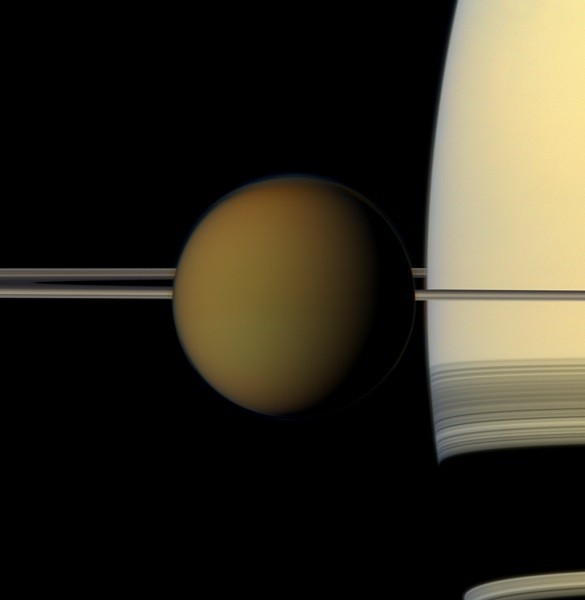By Ana Verayo, | September 21, 2016

The hazy globe of Titan hangs in front of Saturn and its rings in this natural color view from NASA's Cassini spacecraft.
Cloud formation on Earth and other planets or moons involves a certain amount of vapor condensation. Saturn's moon Titan has ice clouds which are virtually devoid of any vapor; this made the appearance of cloud on Titan a strange sight for NASA mission scientists.
In a new study, scientists revealed that Saturn probe Cassini detected a unique compound on one of Titan's ice clouds, known as dicyano acetylene (C4N2), which is made of carbon and nitrogen. With the help of a sensitive scientific instrument onboard Cassini, known as the composite infrared spectrometer (CIRS), this C4N2 cloud in Titan's atmosphere has been confirmed to possess no vapor.
Like Us on Facebook
Mission scientists theorize that this cloud formation is based on "solid state chemistry," which is a process that begins with solids as opposed to gasses.
The theory suggests that grains of ice form a chemical called cyanoacetylene (HC3N) which fall into Titan's stratosphere and become covered in an ice shell made of hydrogen cyanide (HCN). This could explain how vapor-less clouds are formed on Titan.
On Earth, a similar process can also occur in our stratosphere when there is less moisture. In our stratosphere, ice crystals can act as seeds where chemical compounds with chlorine can attach themselves. This creates a reaction; forming a cloud and releasing chlorine molecules that can damage the ozone layer. This cloud is formed chemically sans condensation, similar to the vapor-less clouds found on Titan.
According to the lead author of the study Carrie Anderson, who is a CIRS co-investigator, it is truly exciting to think that there are similar examples of solid-state chemical processes on Titan and Earth.
According to CIRS principal investigator Michael Flasar from NASA's Goddard Space Flight Center, the compositions of the polar stratospheres on Titan and Earth are not that different, as the underlying physics of both atmospheres create analogous cloud chemistry.
This new study has been published in the journal Geophysical Research Letters.
-
Use of Coronavirus Pandemic Drones Raises Privacy Concerns: Drones Spread Fear, Local Officials Say

-
Coronavirus Hampers The Delivery Of Lockheed Martin F-35 Stealth Fighters For 2020

-
Instagram Speeds Up Plans to Add Account Memorialization Feature Due to COVID-19 Deaths

-
NASA: Perseverance Plans to Bring 'Mars Rock' to Earth in 2031

-
600 Dead And 3,000 In The Hospital as Iranians Believed Drinking High-Concentrations of Alcohol Can Cure The Coronavirus

-
600 Dead And 3,000 In The Hospital as Iranians Believed Drinking High-Concentrations of Alcohol Can Cure The Coronavirus

-
COVID-19: Doctors, Nurses Use Virtual Reality to Learn New Skills in Treating Coronavirus Patients







